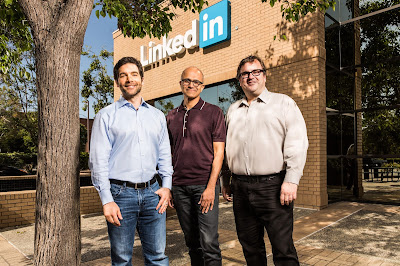By agreeing to a $196 a share takeover from Microsoft MSFT -2.62%, LinkedIn LNKD +46.64% is taking a mulligan on 2016.
After all, LinkedIn, a must use social network among job seekers and corporate human resource departments, is agreeing to an acquisition that doesn’t even return the company to its beginning of year share price. Some might look at LinkedIn’s $26.2 billion pricetag as a middling feat of deal-making for CEO Jeffrey Weiner and billionaire founder Reid Hoffman.
But Microsoft’s takeover solves a major problem for LinkedIn. The company’s high 20%-to-mid-30% revenue growth simply was not enough to appease increasingly flighty stock market investors, who abandoned LinkedIn at the beginning of 2016 on earnings results and guidance that would amount to a banner year for most other large tech firms.
In February, LinkedIn saw its shares plunge over 30% after announcing full-year results and guidance that fell short of investor expectations. The plunge took LinkedIn to multi-year lows not hit since mid-2012, when the company was a third of its size. By mid-month, LinkedIn was testing prices below $100 that it hit on its first day of trading five year ago.
What was it that spooked investors so much?… Accounting problems? Management turmoil? Balance sheet issues? New competitive threats?… The answer is none of the above.
CEO Jeff Weiner has ably (and quietly) steered LinkedIn since its May 2011 initial public offering, and founder Reid Hoffman has remained as chairman of the company, providing stability and a consistent strategic focus.
During its life on public markets LinkedIn has carved out a strong, cash generating niche in the crowded world of social networking by focusing on jobs and career networking, offering HR departments a bevy of new tools to screen for candidates. LinkedIn has tripled its revenues since 2012, and the strength of its business model is also reflected in its balance sheet, which carries $3.16 billion of cash and cash equivalents and just under $1.4 billion of convertible and long-term debt.
It turns out the problem for LinkedIn was that it reported *just* a 34% increase in fourth quarter sales as its online ad sales grew 20%, or roughly half its previous rate of growth. It also offered guidance of about 25% sales growth in 2016. To be sure, those figures represented a slowing from the 40%-plus sales growth rates LinkedIn enjoyed in previous years. But the market reaction was swift and brutal.
By mid-February, LinkedIn, which opened 2016 at over $220 a share, was testing $100. The tumble shaved a cool $1 billion from founder and chairman Hoffman’s net worth.
Now, after a four month stay in the stock market doldrums, LinkedIn is back around $200. Microsoft’s takeover shows investors were wrong to dump LinkedIn en masse. It turns out the February plunge coincided with a deepening of M&A discussions between LinkedIn and Microsoft. If Weiner and Hoffman decided they were tired of myopic stock market investors, who would blame them?
In Fact, LinkedIn’s 2016 round trip is not a unique phenomena.
There are numerous other fast growing tech companies who had their stocks destroyed this year after issuing soft earnings and guidance into a panicked market. And many of these companies are taking the same route as LinkedIn. They are abandoning the stock market in favor of stable partners that see more long-term value in their business and growth prospects.
Quietly, there is a wave of IT, software, hardware, and social networking M&A brewing on Wall Street.
In recent months, firms such as SolarWinds SWI +%, Qlik, Marketo, Demandware, and Cvent have all struck take-private deals. All of these firms sold shares to the public in the 2009-to-2015 range, but are now giving up on navigating the stock market as independent companies.
On Sunday evening, Bain Capital’s Blue Coat Systems decided to strike a $4.65 billion merger with Symantec SYMC +5.35%, instead of listing its shares on public markets. Another seminal deal was a decision by Hewlett Packard Enterprise CEO Meg Whitman to spin and merge the company’s enterprise division with Computer Sciences CSC -0.17% in late May, a deal that revived investor interest in both companies.
As FORBES noted earlier in June, this M&A wave indicates private equity and cash-rich strategic buyers are lining up to scoop up busted technology stocks. And it’s unlikely that the buying is going to slow anytime soon. Stock market jitters seem to be increasing in this election year and tech firms trading at high price-to-earnings multiples are be bearing the brunt of investors’ rush to the exits.
If stock market investors lost their enthusiasm on LinkedIn due to one bad quarter and a weak guidance, Microsoft sees long-term promise. On Monday, it celebrated LinkedIn’s 19% user growth, burgeoning mobile usage, and over 100% job listings growth.
“The LinkedIn team has grown a fantastic business centered on connecting the world’s professionals,” Microsoft CEO Satya Nadella said when describing why he targeted LinkedIn as his first major deal at the helm of Microsoft. “Together we can accelerate the growth of LinkedIn, as well as Microsoft Office 365 and Dynamics as we seek to empower every person and organization on the planet,” Nadella added.
Jeff Weiner will remain CEO of LinkedIn, reporting to Nadella and Monday’s deal has the support of controlling shareholder Reid Hoffman.
Microsoft will finance the acquisition primarily through the issuance of new debt, and the deal is expected to be 1% dilutive to its 2017 EPS, but accretive in less than two years post-closing. Microsoft also reiterated its intention to complete a $40 billion share buyback by December 2016.
LinkedIn shares surged over 47% in early trading, while Microsoft shares fell over 3%.
Morgan Stanley is advising Microsoft, while Qatalyst Partners and Allen & Company are advising LinkedIn. Law firm Simpson Thacher & Bartlett is working with Microsoft, Wilson Sonsini Goodrich & Rosati is working with LinkedIn.

Комментариев нет:
Отправить комментарий